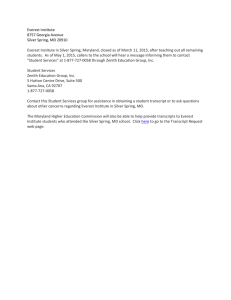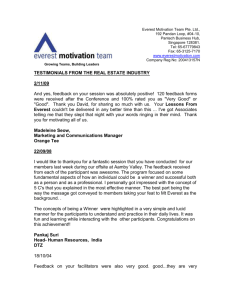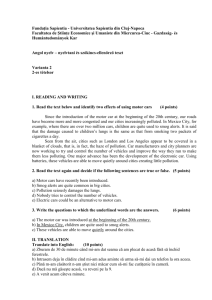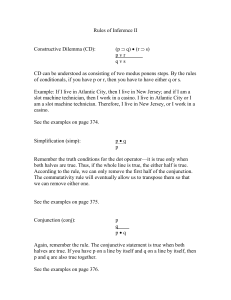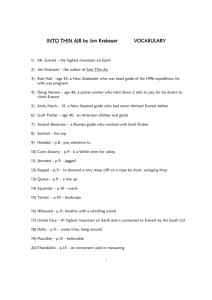Dave_Mills - Automotive Aftermarket Suppliers Association
advertisement
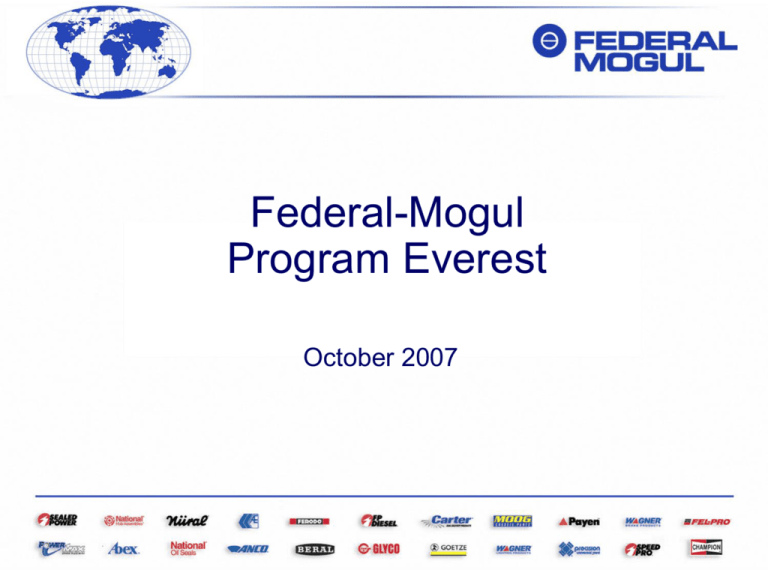
Federal-Mogul Program Everest October 2007 Company at a Glance Sales: $6.3 Billion Employees: 45,000 Globally Global Locations: 109 Manufacturing and 21 Distribution sites worldwide operating in 35 countries Research & Development: 15 Globally-Networked Technology Centers in North America, Europe and Asia Key Industries: Automotive, light commercial, heavy-duty truck, off-highway, agricultural, marine, rail and industrial Information Systems Data classification: Public 09/19/2007 2 Global Business Sales by Geographic Region $6.3 Billion Global Sales $6.3 Billion OE 60% Light Vehicle $2.2 Billion Industrial & Heavy-Duty $1.6 Billion EMEA 40% Asia Pacific* 8% Aftermarket $2.5 Billion Aftermarket 40% Americas 52% *Includes 100% of sales through minority held Joint Ventures Information Systems Data classification: Public 09/19/2007 3 OE Global Market Position Pistons and Rings Information Systems Bearings Valve Seats and Guides Data classification: Public Friction Sealing 09/19/2007 4 Aftermarket Market Position Europe Friction Chassis #1 #1 Gaskets Engine #1 #1 Gaskets Engine Wipers Ignition #3 #3 North America Friction #1 Information Systems Chassis #1 #1 #1 Data classification: Public Wipers Plugs #1 #2 09/19/2007 5 Original Equipment Customer Base OPTION 1 Each of the logos/trademarks shown above are the properties of their respective owners. Information Systems Data classification: Public 09/19/2007 6 Customer Base OPTION 2 Original Equipment (OE) Global Aftermarket (GA) Each of the logos/trademarks shown above are the properties of their respective owners. Information Systems Data classification: Public 09/19/2007 7 IS and Business Units: Friend or Foe? Achieving the Goal • First, agree on where you are going • Agree on barriers to success that can be influenced • Align each function with that vision and ensure that the strategies are translated into coordinated tactical plans that break the barriers • Get the right team and focus on execution It’s About Teamwork Information Systems Data classification: Public 09/19/2007 8 Strategic Alignment Comes First Path to Global Profitable Growth Global Profitable Growth Execution Tactical Planning and Collaboration Strategic Alignment Agree on where you are going, what barriers need to be broken and align all departmental strategies Information Systems Data classification: Public 09/19/2007 9 Driving Global Profitable Growth The Target is to Satisfy Customer, Employee and Stakeholder Expectations • Develop a global leadership team to achieve breakthrough performance • Anticipate customer and market requirements to accelerate delivery of value-added solutions to the marketplace • Provide leading technology and innovation in products and services to improve vehicle performance and exceed customer expectations • Create a global lean enterprise with world-class engineering, best cost manufacturing, sourcing and supply chain • Grow global profitable business and develop long-term sustainability The Drive for Global Profitable Growth is a Must, not an Option Information Systems Data classification: Public 09/19/2007 10 Global IS Strategy • Investments focused on strategic projects • Standard enterprise solutions • A buy vs. make approach to software development • SAP integration across the business • Intellectual capital maintained in the function • Selective sourcing of non-strategic assets/activities Information Systems Data classification: Public 09/19/2007 11 Current Environment • Heritage of multiple acquisitions • Chapter 11 • Intensive scrutiny • Customer diversity • Distribution channels • Technology leader • Global player Information Systems Data classification: Public 09/19/2007 12 Constraints to Business Change • Federal-Mogul’s stand-alone systems, archaic point-to-point interfaces, and off-line analytic tools result in high maintenance costs and multiple single points of failure • Islands of information across the company result in a need for hundreds of company IS and Business staff to maintain, adjust, report, reconcile, reformat, and re-report • Business processes are not uniform and consistent across the enterprise, a barrier to rapid decision making • Multiple data sources from disconnected systems lead to duplication of effort to synchronize critical business information (customer, supplier, materials master data) Information Systems Data classification: Public 09/19/2007 13 Where We Moved From… In 2005 IS was not representing an adequate lever to enable the priorities set by the new management THE IS SITUATION AS OF SEP. 2005 … … AND THE IMPACT ON THE BUSINESS Historically F-M has operated in a very decentralized manner from both a business and technology perspective. This has resulted in a very fragmented application landscape. 1 Limited ability to serve the business and improve customer satisfaction 2 Lack of integration and visibility across the supply network 3 Lack of consistent, common, accurate, business measurement 4 Business Continuity Risks, Compliance 5 Stifled innovation and poor capability to follow business growth strategy 6 High IS costs, high complexity to manage, low IS effectiveness # unique application 382 # application instances 690 # SAP environments 11 # Master data bases Process Proliferation Master Data Proliferation Technology Proliferation 633 See the Appendix for details Information Systems Data classification: Public 09/19/2007 14 The IS Situation as of Sep. 2005 Master Data Proliferation Federal-Mogul currently uses approximately 633 different master data bases: MASTER DATA FILES CUSTOMER PRICING PART ITEM #81 #67 #76 #84 SUPPLIER INVENTORY LOCATION ORDER #55 #54 #14 #64 FIN. ACCT EMPLOYEE PRODUCT #47 #48 #43 Back Information Systems Data classification: Public 09/19/2007 15 The IS situation as of Sep. 2005 Process Proliferation (Order To Cash) • Federal-Mogul operates multiple distinct order to cash processes/systems that differ by business and geography • The diversity is a result of a historically autonomous business unit alignment, with a decentralized approach to IS (i.e, IS was a friend at the BU level) • System platforms have developed as non-integrated enhancements within themselves. Roll-outs within the Business Units are based on proprietary knowledge • Information reporting above the business unit level is difficult due to inherently different system logic and lack of drill down capabilities (i.e., IS was a Foe at the corporate level) Back Information Systems Data classification: Public 09/19/2007 16 Align Investments and Teams Path to Global Profitable Growth Global Profitable Growth Execution Tactical Planning and Collaboration Strategic Alignment Focus investments on achieving the goal Align organizational structures Develop and enforce a strong governance model Information Systems Data classification: Public 09/19/2007 17 Business - IS Value Map Roadmap to the Global Enterprise Revenue Enhancement and SG&A reduction IS Investment Business Process Standardization Cost Savings Infrastructure Standardization 1. E-mail 2. Desktop Environment 3. PCs 4. LAN/WAN 5. Knowledge Systems 6. L.Notes ,Sharepoint Information Integration 1. HR & Finance 1. Common product Processes 2. Order Fulfillment processes 3. Bid to cash processes customer codes 2. Comprehensive Global Information repository 3. Real Time business intelligence Hardware Consolidation 1. Server Consolidation 2. Data Center Consolidation 3. Regional Help Desk Time Information Systems Data classification: Public 09/19/2007 18 SAP as the New Systems Backbone It is the industry leader in global ERP applications, including automotive ONE SAP FOR ONE FEDERAL MOGUL SAP offers “best in class” functionalities We already used it (and paid for it) SAP guarantees continuous evolution Most Competitors and Customers do the same SAP is the perfect base to build a Corporate environment that spans multiple regions of the world, has diverse business units and is oriented to have an organization and business processes that adapts quickly to emerging business needs. Information Systems Data classification: Public 09/19/2007 19 Program Everest Launched in late 2005, it represents one of the biggest investments of the corporation GOAL, APPROACH AND PHASES Goal Implement common, global business processes utilizing SAP as the ERP application for the entire corporation Phase 0 Global Model Design for the core corporate processes (Finance, Sales, Material Management) APS Distributions Centers Phase 1 Solution Extension (pricing, rebates, commissions, warehouse management, …) Design Approach Pilot Roll-Out Information Systems Conceived to manage complexity, minimizing costs and risks Manufacturing Phase 2 • Solution Design and Prototype • Implementation Asia Pacific Phase 3 Data classification: Public Deployment in some selected facilities (SPG Japan, Wuhan, Quingdao, …) 09/19/2007 20 Program Everest: The Challenge Managing Program Everest means to manage a huge change both from a business and a IS perspective THE CHALLENGE BEHIND PROGRAM EVEREST Homogenize business practices A quantum leap for the business Reduce complexity, manage risks, ensure compliance Increase efficiency and effectiveness Improve Business Control Demonstrate the capability to successfully manage a complex program A quantum leap for the IS function Provide the ability to manage and govern the new platform Reduce complexity and costs, increasing the service level Information Systems Data classification: Public 09/19/2007 21 Strong Governance Model Focus Resources on the Goal • Strong management and governance over a smaller number of projects drive improved performance • Manage the demand for IS services • Measure performance and particularly on-time delivery Information Systems Data classification: Public 09/19/2007 22 IS Organization CISO Process Design Organization (Solution Design) Governance and Performance Management Information Security Service Delivery Organization (The Factory) Business Unit Leaders (Client Focused) IS Business Unit Leaders report directly to the CISO and sit on the staff of the Leader for each Business Unit Information Systems Data classification: Public Strategic Programs (Delivery Focused) Responsible to understand • Business Unit and Product Strategies • Business Plan • Tactical business requirements and IS support needs 09/19/2007 23 Everest Program Organization Core Central Team Executive Committee Local Leadership Key Users Deployment Business Leadership Business Experts Support Information Systems IS Roles: Business Roles: Central Team (Everest Core Team, Business Unit Manager and PEGs, Security, Infrastructure) Business Experts (BPOs, BPLs, SMEs, Central Functions, e,g. Finance) Deployment Local SAP consultants Local Leadership Team (Site Director and his direct reports) Support Organisation (T-Systems, Change Board, Security, Legacy Systems ) Key Users* (from deploying site and future deployment locations) * Resourcing business activities (testing, training, data validation) with key users from future deploying sites will accelerate those deployments and decrease resource strain on currently deploying site Information Systems Data classification: Public 09/19/2007 24 Execution Path to Global Profitable Growth Global Profitable Growth Execution Tactical Planning and Collaboration Focus investments on achieving the goal Strategic Alignment Information Systems Data classification: Public 09/19/2007 25 Program Everest Global Business Organization Information Systems Data classification: Public 09/19/2007 26 Our Achievements Success of the initiative evaluated from different perspectives PROGRAM EVEREST RESULTS 1 Business Coverage 2 New Integrated Processes 3 Master Data 4 Technology Platform 5 Information Systems IS Organization • Everest is now supporting a significant portion of the F-M business • New, common and integrated processes are now in place • A unique, cleansed, consistent and centrally managed repository is available • Several legacy applications have been switched off • A new, unique and standard system architecture is now in place • A complex program organization is now capable to manage quickly different streams in parallel • A single organization is supporting all our users Data classification: Public 09/19/2007 27 Business Coverage The F-M Business currently supported by Everest is significant after only 18 months CURRENT EVEREST BUSINESS SCOPE Business Units APS BE Kontich (CH Geneve) APS IT Verona APS IT Mondovì (R&M) APS ES Madrid (Espana) APS ES Barcelona (Iberica) APS FR Boulogne (Gif) APS UK Bradford APS DE Marienheide APS CZ Kostelec SPG Japan Countries Legal Entities Business Units 9 10 10 Locations SAP Users 21 719 See the Appendix for details Information Systems Data classification: Public 09/19/2007 28 Integrated Process The Everest solution enabled to manage in the same environment a full set of integrated business processes EVEREST PROCESS COVERAGE To support the different business models, different “solution sets” Solution sets Process Scope and Integration Degree of sophistication Information Systems were implemented inside Everest: Large CDC, Medium LDC, Small LDC, Local Commercial Agency, “Light” Manufacturing Facility A wide range of processes (OTC, PTP, SCE, FIN) are supported by Everest A unique degree of integration is ensured within SAP and with other external applications A significant degree of sophistication and automation was introduced to improve the core business processes, especially in the SCE and OTC area Data classification: Public 09/19/2007 29 Master Data They are the cornerstone of the system as they drive the process behavior MASTER DATA REPOSITORY A common, shared repository Centralized Management All relevant master data are stored in the same environment (with a single naming convention) and shared by the business across the different countries and business units Contracts 11 K 3K Materials Source Lists 117 K 912 K Vendors Pricing & Discounts 5K > 12 M SAP enabled the centralized management of our master data, to ensure consistency, stewardship and flexibility The data migration task represented a Migration Customers (Sold-To) critical task for Everest in terms of: - management of high volumes of data - ensuring the proper cleansing activities Information Systems Data classification: Public 09/19/2007 30 Technology Platform We introduced a sophisticated, lean architecture based on our new SAP backbone INFORMATION SYSTEM ARCHITECTURE Everest brought a drastic simplification of our application map We switched off several applications, stopping their Application Architecture maintenance costs The IBM Mainframe (POPIMS) Platform is no longer needed to support the Business SAP has been interfaced with several different application to ensure reporting and extended supply chain capabilities Together with the introduction of the new SAP based Infrastructure Architecture application layer, also our technology infrastructure made a quantum leap towards innovation and standardization We integrated several components to build a sophisticated architecture Information Systems Data classification: Public Migrated Applications 20 Switched Off Applications 13 Interfaced Applications >10 New SAP Data Center New Global Network (Nexus) New Xerox Printers New RF Technology 09/19/2007 31 IS Organization We increased our ability to manage the project and the maintenance cycle OUR IS ORGANIZATION EVOLVED TO MANAGE COMPLEXITY Program Everest Organization From … … To One Project Team > 10 Project Teams One single stream 6 parallel streams One Prime Contractor 4 Consultancy Companies Strong presence of external F-M internal resources in key consultants in the key positions management positions A new, not consolidated A Standard and run-in approach to methodology to run the project manage the deployment phase 8 months to manage the 1st roll-out 5 months to manage the UK roll-out More than 700 users in 9 countries are now supported by the same Service Delivery Organization Information Systems organization (powered by Dell and T-Systems), adopting a global procedure and ensuring local business (language and time) coverage Our infrastructure team (located in Southfield and Manchester) is committed to a 7x24 availability of our network and data center and support the other components of the Everest technology (RF, printers, desk-tops) Data classification: Public 09/19/2007 32 Managing the Change Organizations Work Together Processes Work Together Business, functions, and employees can leverage a world wide dimension and face the market as a Corporation • • • Design and implement uniform and lean • business processes, oriented to • customer (internal or external) loyalty • • Data Work Together Data is unique, updated real-time, and aligned • • • Systems Work Together Information Systems Move to a system environment, with specialized, flexible modules Data classification: Public • • Build Knowledge Spread Corporate Culture Share Experiences Reduce Lead Time Improve Change Readiness Increase Customer Service Increase Data Availability and Accuracy Improve Analysis Capabilities Accelerate Decision Process Reduce System Costs and Investments Improve Customer Support Faster Deployment of New Solutions 09/19/2007 33 Concurrent Change - Desktop & Networking We increased our ability to accelerate deployments of Program Everest by standardizing and simplifying many components of the overall IS solution Federal-Mogul 2006 F-M DESKTOP & NETWORKING STRATEGY TARGET BENEFITS • New features & collaboration based services •Alleviate user frustration •Raise the workforce capability • Eliminate redundancy & overlapping Legacy desktop and network technology platform was unnecessarily complex, with redundant components and poor system integration performance. Information Systems Migration to Microsoft products providing seamless, integrated technology platform for the desktop and network. Data classification: Public expense • Part of broader strategy that facilitates enterprise mgmt. 09/19/2007 34 Business Priorities and Trends Emerging & Developing Technologies Automotive suppliers will continue to focus on the integration of internal and external operations. A number of new and emerging technologies are helping to drive that trend. These include: Web-based supplier portals •Simplifies the task of linking various partners and enabling collaboration among decentralized operating groups Online exchange of data •Enables extensive information sharing and the linking of processes – and an enhanced ability to control costs Master data management •Allows collaborating organizations using disparate systems work with consistent, accurate information across the supply network Product life-cycle solutions •Display digital models and increase speed, precision, and efficiency in product engineering, manufacturing, and life-cycle support RFID technology •Enables the automatic tracking of goods through the supply network. RFID has the potential to streamline parts management and distribution, and provide new levels of visibility into product life cycles Business intelligence tools •Allows suppliers to analyze costs, production, and markets, and gain insights that can boost efficiency, target and accelerate product development, and improve overall profitability Integrated software •Links processes in critical areas, including ERP, supplier relationship management, supply chain mgt, service parts planning and mgt, customer relationship mgt, and product life-cycle mgt. These integrated systems can cut time and costs out of process Source: Strategies For Profitable Growth - SAP 2004 Information Systems Data classification: Public 09/19/2007 35 Way Forward “Ex-e-cu-tion (ek si kyoo shun), n. 1. The missing link. 2. The main reason companies fall short of their promises. 3. The gap between what a company’s leaders want to achieve and the ability of their organizations to deliver it. 4. Not simply tactics, but a system of getting things done through questioning, analysis and follow-through. A discipline for meshing strategy with reality, aligning people with goals, and achieving the results promised. 5. A central part of a company’s strategy and its goals and the major job of any leader in business. 6. A discipline requiring a comprehensive understanding of a business, its people and its environment. 7. The way to link the three core processes of any business - the people process, the strategy and the operating plan - together to get things done on time. 8. A method for success discovered and revealed in 2002 by Larry Bossidy and Ram Charan in Execution: The Discipline of Getting Things Done” Information Systems Data classification: Public 09/19/2007 36

